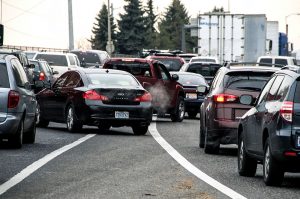We all hate traffic. But do you hate it enough to start carpooling more? Lyft’s co-founders just published some ideas on how we can put an end to rush hour traffic and they think incentivizing people to carpool is the key to clearing the highways and reducing our daily dose of road rage.
In a Medium post, co-founders Logan Green and John Zimmer propose an idea that sort of merges the concept of the carpool lane with surge pricing. In their “smart lane” proposal, high-occupancy vehicle (HOV) lanes would open up anytime traffic got too heavy. Carpools of three or more people would be able to use the lane for free while everyone else would get charged a market-based fee based on how backed up the traffic is.
So if you really want to add your single-occupant car to the already congested line of gas guzzlers, go right ahead. Just be ready to pay out-of-pocket for contributing to the problem. Or you can opt to alleviate traffic through carpooling and get rewarded with a free ride.
“This gives consumers a choice in how to move around more efficiently and can be implemented with very low-cost digital and physical infrastructure,” the co-founders write. “All funds generated by smart lanes will be invested back into local infrastructure projects.”
Undoubtedly, ride-sharing companies like Lyft and Uber have a lot to gain from any government policy that would set aside specialized lanes for carpoolers. But the thought experiment does force us to ask how we could change the way we move on the road today.
As we reckon with ever-increasing levels of gridlock with matching portions of smog, cities and municipalities all around the world are forced to come up with novel approaches to better manage their transportation infrastructure. London, Stockholm and Singapore have all played around with the idea of congestion pricing. Other cities like Beijing and New Delhi have experimented with rationing policies that give alternating turns on the road based on the odd or even numbering of your license plate.
In the U.S., just incentivizing people to make use of their empty car space poses a huge opportunity. To back up that argument, MIT recently conducted a study that found New York City’s fleet of 13,000 taxis could be reduced to 3,000 carpool cars. The more butts we get into empty passenger seats, the more time and free space we get back from the road.
And despite a decline in carpools in recent decades, we have a unique chance to reverse the course now due to changing attitudes about ride-sharing and the advent of new technologies to help manage traffic at lower cost. At least according to Lyft, carpooling is ready for a comeback.











